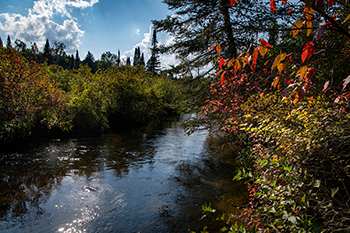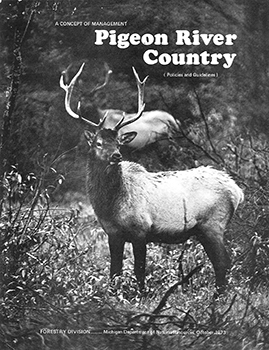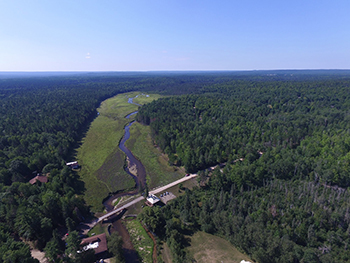Fifty years of collaboration to preserve ‘The Big Wild’
By CASEY WARNER
Michigan Department of Natural Resources
In the middle of Michigan’s northern Lower Peninsula, just a few miles northeast of Gaylord, lies a special place known as "The Big Wild."
This unique, rustic area known for its seclusion from civilization – a young Ernest Hemingway called it “wild as the devil” and “the greatest I’ve ever been in” – became the Pigeon River Country State Forest in 1919.

The forest began as 6,468 acres of tax-reverted land and has grown to 109,000 acres, 12 miles wide and 20 miles long, making it the largest block of contiguous undeveloped land in the Lower Peninsula. It’s home to one of the largest free-roaming elk herds east of the Mississippi River and offers abundant opportunities to explore the outdoors.
Michigan residents have long valued the Pigeon, as it’s often called, for its natural splendor and wild character. And 50 years ago, when controversy arose around use of the forest, a group of those residents was called upon to help decide how to manage it.
In the 1960s, the Michigan Department of Natural Resources began leasing state land, including much of the Pigeon River Country State Forest, for oil and gas exploration.
Oil was discovered in the Pigeon in early 1970, and later that year, more than 700 people attended a DNR public hearing on oil and gas issues, most opposed to continued development in the forest.
When lawsuits were filed over oil and gas drilling in the Pigeon River Country State Forest in the early 1970s, the DNR put a special management plan in place for the forest.
The council’s early years
In December 1973, the Michigan Natural Resources Commission approved a Pigeon River Country Concept of Management. The plan included creation of the Pigeon River Country Advisory Council, with members representing conservation, oil and gas, and recreation viewpoints.
|

In 1974, DNR Director A. Gene Gazlay appointed the first members of the Pigeon River Country Advisory Council.
Gazlay’s charge to the advisory council framed it as a “broadly representative citizen advisory body” and “a key provision of the conceptual management plan developed by the Department and approved by the Commission.”
The council’s duties and responsibilities, as outlined by Gazlay, include seven objectives. Among those, helping the DNR "in framing management programs which will assure wise future use of the Forest's varied resources, minimize and harmonize conflicts to the extent possible, and above all, insure wise conservation of the special resource values for present and future generations to use and enjoy.”
One of the council’s first members, and vice-chairman at its first meeting, was Dave Smethurst, avid Gaylord-area trout fisherman and one of the founding members of the Headwaters Chapter of Trout Unlimited.
Smethurst, who passed away in 2021, talked about the formation and original members of the Pigeon River Country Advisory Council in the video “Advisory Council: A Bold Idea.”
“Smart, experienced, knowledgeable people … It was all these smart people coming together and saying, how can we make this work? I don’t know that the forest could have succeeded, I’m sure it couldn’t have succeeded as well, without the advisory council because controversial issues, the department could hand off to the advisory council for advice, and it wasn’t the ‘damn DNR’ doing it, it was a group of citizens,” Smethurst said.
The Concept of Management created the council with diverse membership drawn from conservation, oil and gas, and recreation interests.
|

In the book “Pigeon River Country: A Michigan Forest,” Dale Clarke Franz called it “the state's pioneering experiment in involving people of opposing views in the long-term management of its natural resources." Franz also wrote, "As a result of the controversy, an advisory council of citizens was established and given an official role in setting forest policy. Many people opposed to hydrocarbon development were appointed to the council. They were ultimately unable to prevent drilling, but at least sat down with representatives of other points of view, including members of the hydrocarbon industry, in an effort to make the best decisions possible.”
Later in the book, he added, "In retrospect, they were exciting times, when ordinary citizens began to sit in rooms with the highest-level politicians and representatives of one of the most powerful industries on earth, not making speeches but talking to each other."
Ned Caveney, who was appointed area forester for the Pigeon River Country State Forest in January 1974, recalls the first advisory council meetings that began in July that year.
Caveney said that, at the outset, he was “very concerned at how well this would all work” and questioned whether the group could really be successful at meeting all the management objectives it was charged with, but “the Concept of Management and the Charge to the Council were the important guiding documents.”
During four council meetings that took place over six days in 1974, Caveney said, “It was evident that the majority of the council members took their role very seriously.”
One controversy resolved, another emerges years later
In 1980, the debate over oil drilling in the Pigeon came to a close with a compromise settlement that formalized the advisory council, protected the northern two-thirds of the forest from oil and gas development, and laid out many provisions for development in the southern third of the forest.
"Nobody had a won a clear victory, but neither had the forest suffered a clear loss," wrote Dave Dempsey in the book “Ruin and Recovery: Michigan’s Rise as a Conservation Leader.”
One outcome of the oil and gas controversy was the 1976 creation of the Kammerer Land Trust Fund, precursor to the Michigan Natural Resources Trust Fund, under which royalties from oil and gas would be directed to a land trust fund to acquire recreational lands.
In addition to oil and gas development, the Pigeon River Country Advisory Council has provided input to the DNR on many issues including road access and equestrian use of the forest.
|

As stated in the advisory council’s charge document, the group’s charge “is necessarily broad and general. Many of the problems and issues to which the Council will address itself are identifiable now; others not presently foreseen undoubtedly will arise. The Department welcomes the Council’s sharing in the stewardship of this State Forest and its wonderful wealth of resources.”
John Walters, currently a member of the Michigan Natural Resources Commission, was appointed to the Pigeon River Country Advisory Council in 2008, representing Trout Unlimited, and served as the council’s chair from 2010 to 2018.
Walters recalls that he and fellow advisory council members addressed many issues, ranging from gas and oil to forestry, wildlife, fisheries and acceptable uses of “The Big Wild.”
“However, one event stands out above all other issues,” he said. “On June 23, 2008, an event occurred that changed my life and perhaps others on the council, as well.”
On that date, the Song of the Morning Dam malfunctioned, draining the impoundment and sending tons of sediment downstream on the Pigeon River, killing over half a million trout.
The DNR filed a lawsuit against Golden Lotus, owner of Song of the Morning Ranch. Trout Unlimited and the Pigeon River Country Association joined together to also file a lawsuit against Golden Lotus. The advisory council fully supported the lawsuit, with four council members, including Walters, party to the case. The main objective of this team was to get the Song of the Morning Dam fully removed.
|

While initially expected to be a two-year process, with litigation and negotiation, the lawsuit took six years to resolve.
“The team routinely updated the entire council with the progress of the case. Never did the council waiver, full steam ahead. This process tested the team’s negotiation skills, and patience, but they were steadfast to seek full dam removal,” Walters said. “The team also recognized that if/when they prevailed, they would have to work with Song of the Morning on a dam removal project and sediment management plan.”
In April 2015, when the judge ruled in favor of Trout Unlimited and the Pigeon River Country Association, Walters said each side met in the aisle, shook hands and said, “Now the real work begins.”
In May 2015, the dam drawdown began. Read more about the Pigeon River dam removal project.
“We can all be proud of a successful dam removal, free-flowing Pigeon River, fish and macroinvertebrate passage and cold water flowing past Song of the Morning Ranch,” Walters said. “It was very important to the team that the Pigeon River Country Advisory Council fully supported these efforts and did not waiver throughout the lengthy process.”
Into the future
Today, the Pigeon River Country Advisory Council is comprised of 18 citizen members, three ex-officio members from the DNR and one ex-officio member from the Michigan Department of Environment, Great Lakes, and Energy.
|

“Over the 16 years that I worked with the council I am proud of how effective the council was. They made a difference helping the DNR deal with many controversial issues, most noted were oil and gas development and the elk management plan,” Caveney said.
“At 50 years we can celebrate the contribution of a lot of dedicated people that served many years. We can also ask how successful have we been in meeting those seven objectives as we look forward to the next 50 years.”
Find more information about the council, including member and meeting information, on the Pigeon River Country Advisory Council webpage.
Check out previous Showcasing the DNR stories at Michigan.gov/DNRStories. To subscribe to upcoming Showcasing articles, sign up for free email delivery at Michigan.gov/DNREmail.
|
Note to editors: Contact: John Pepin, Showcasing the DNR series editor, 906-226-1352. Accompanying photos and a text-only version of this story are available below for download. Caption information follows. Credit Michigan Department of Natural Resources, unless otherwise noted.
Text-only version of this story.
Aerial: An aerial view of the former Song of the Morning dam site on the Pigeon River. The Pigeon River Country Advisory Council played a key role in the effort to get the dam removed. (Photo courtesy of John Walters)
Concept: In December 1973, the Michigan Natural Resources Commission approved a Pigeon River Country Concept of Management. The plan included creation of the Pigeon River Country Advisory Council.
Elk: The Pigeon River Country State Forest is home to one of the largest free-roaming elk herds east of the Mississippi River.
Group: Members of the Pigeon River Country Advisory Council take a group tour to the forest’s Inspiration Point. (Photo courtesy of Lisha Ramsdell)
Oil: Debate over oil and gas development in the Pigeon River Country State Forest led to creation of the advisory council. Today, royalties from oil and gas development on state-managed lands go into the Michigan Natural Resources Trust Fund, used to acquire recreational lands and develop public recreation facilities.
Rainbow: A rainbow over fall foliage in the Pigeon River Country State Forest.
Ribbon: A ribbon-cutting ceremony celebrating a dam removal on the Pigeon River at the former Song of the Morning dam site.
River: The Pigeon River flowing through Pine Grove State Forest Campground in the in the Pigeon River Country State Forest.
Trout: When the Song of the Morning Dam malfunctioned in 2008, draining the impoundment and sending tons of sediment downstream on the Pigeon River, over half a million trout were killed. (Photo courtesy of John Walters)
Work: Work to remove the Song of the Morning Dam – and improve the aquatic habitat and water temperature conditions downstream and allow fish passage upstream – is shown. (Photo courtesy of John Walters)
|